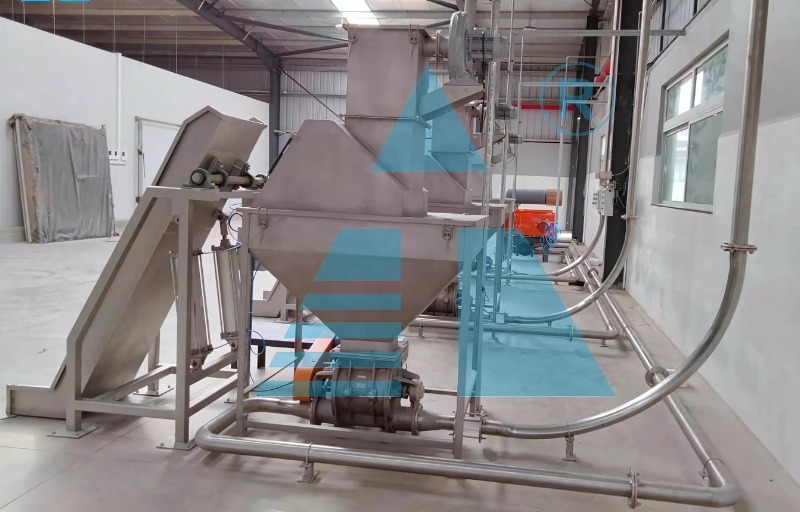-
Send us a mail [email protected]
-
Call us anytime +91-9999884400

These systems play a critical role in improving operational efficiency, reducing contamination risks, and maintaining workplace safety. For chemical manufacturers handling powders like pigments, catalysts, detergents, or resins, a reliable powder conveying system ensures consistent product quality while adhering to strict industry standards.
The Role of Powder Transfer Systems in Chemical Industries
A powder transfer system for chemical manufacturing plants is designed to safely and efficiently move dry bulk materials from one process to another. This might include transferring powders from drums to reactors, mixers, hoppers, or packaging machines. In chemical plants, where many powders are hazardous or sensitive to moisture and contamination, using a closed-loop powder transfer system helps maintain material integrity and ensures operator safety.
These systems minimize manual handling, which is not only labor-intensive but also introduces risks of spillage, exposure, and product contamination. The implementation of an automated powder transfer system is, therefore, a crucial upgrade for any plant looking to scale its production while ensuring compliance with health and safety regulations.
Types of Powder Transfer Systems for Chemical Manufacturing
There are several types of powder transfer systems for chemical manufacturing plants, each suited for different operational needs:
• Vacuum Transfer Systems – Use negative pressure to move powders in a contained environment, ideal for explosive or toxic materials.
• Pneumatic Conveying Systems – Utilize air streams to transport powders across distances, offering flexibility in plant layout.
• Mechanical Systems – Include screw conveyors, bucket elevators, and belt systems, often used for large-volume transfer but with more maintenance requirements.
Choosing the right bulk powder transfer solution depends on factors like particle size, transfer distance, flow rate, and material sensitivity. Manufacturers often consult industrial powder handling equipment experts to ensure optimal selection.
Advantages of Using a Powder Transfer System in Chemical Manufacturing
One of the primary benefits of integrating a powder transfer system for chemical manufacturing plants is the significant improvement in material handling efficiency. These systems are designed to automate the process, reducing downtime and increasing productivity. Moreover, with less reliance on manual labor, there’s a lower risk of operator exposure to hazardous materials.
A modern chemical powder transfer system also ensures dust-free operation, which is crucial in maintaining a clean and safe working environment. This not only protects workers but also prevents cross-contamination between batches—a vital consideration in multi-product chemical production facilities.
Improved Accuracy and Reduced Wastage
Precision in measurement and dosing is a key factor in chemical production. A well-calibrated powder transfer system for chemical manufacturing plants provides accurate control over the quantity of material transferred, reducing waste and improving batch consistency. This contributes directly to cost savings and better product quality.
Moreover, many automated powder transfer systems can be integrated with process control units, enabling real-time monitoring and automation. This leads to fewer errors, better traceability, and improved quality control throughout the bulk powder handling process.
Compliance with Safety and Regulatory Standards
A powder transfer system for chemical manufacturing plants must comply with national and international safety regulations such as OSHA, ATEX, and NFPA. These systems help manufacturers meet these standards by minimizing the release of fine particles, preventing combustible dust explosions, and reducing operator exposure to hazardous substances.
Modern systems are designed with explosion-proof powder transfer components, easy-to-clean surfaces, and enclosed pathways that align with best practices in chemical plant safety systems. For facilities handling flammable or reactive powders, such systems are not just beneficial—they are mandatory for compliance and long-term operational success.
Custom Solutions for Complex Manufacturing Needs
Every chemical manufacturing facility has unique requirements depending on the products handled, production volume, and existing infrastructure. Fortunately, today’s custom powder transfer systems are highly adaptable. Manufacturers can tailor these systems with features like nitrogen blanketing, batch weighing, vacuum sealing, and dust filtration.
A customized powder conveying solution ensures seamless integration into existing workflows while solving specific challenges—such as transferring hygroscopic or abrasive powders—without compromising efficiency or safety. Working with leading powder transfer system manufacturers helps achieve optimal results.
Reducing Operational Costs Over Time
While the upfront cost of installing a powder transfer system for chemical manufacturing plants may seem high, the long-term benefits far outweigh the investment. Reduced product loss, lower maintenance needs, fewer labor requirements, and minimized safety risks all contribute to lower operational costs over time.
Additionally, a well-maintained industrial powder conveying system can extend equipment life by reducing wear and tear, thus ensuring a more sustainable and cost-effective production environment.
Conclusion: A Smart Investment for Sustainable Growth
In conclusion, a powder transfer system for chemical manufacturing plants is a game-changer for companies seeking to improve productivity, ensure safety, and maintain consistent product quality. Whether handling bulk powders or fine particulate materials, the right powder transfer equipment enhances process efficiency, lowers operational risks, and supports regulatory compliance.
By choosing a reliable, well-designed powder transfer system, chemical manufacturers can future-proof their operations and build a more scalable and sustainable production process. Investing in cutting-edge powder transfer technology is not just a smart move—it’s essential for staying competitive in the evolving chemical industry.
